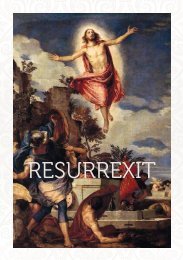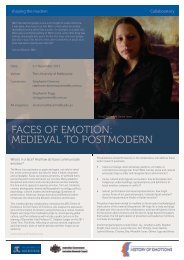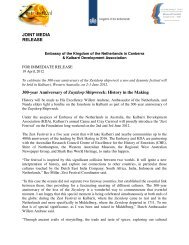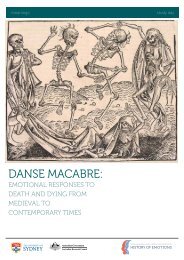Download our K-12 education pack - ARC Centre of Excellence for ...
Download our K-12 education pack - ARC Centre of Excellence for ...
Download our K-12 education pack - ARC Centre of Excellence for ...
Create successful ePaper yourself
Turn your PDF publications into a flip-book with our unique Google optimized e-Paper software.
Supporting Res<strong>our</strong>ces stories <strong>for</strong> teachers & students 2013<br />
Dutch Lives in the World<br />
stories by winthrop pr<strong>of</strong>essor susan broomhall<br />
Abandoned<br />
The Batavia saw some 250 people remain on nearby islands,<br />
while the Vergulde Draeck left 68 passengers ashore while a<br />
small rescue party travelled north to the colony <strong>for</strong> help.<br />
Zuytdorp was the only Dutch wreck from which no survivors from<br />
among the 200 or so aboard had returned to report its fate and to<br />
seek assistance; thus, no search was ever made <strong>for</strong> it by the<br />
VOC. Ninety remained on the islands after the wreck <strong>of</strong> the<br />
Zeewijk while <strong>12</strong> crew left to get help.<br />
The survivors’ initial joy at escaping from the sea must have<br />
turned once more to fear and despair faced with the unfamiliar<br />
surrounds <strong>of</strong> the west coast. First thoughts were to provisions and<br />
locating fresh water where it had not been salvaged from the ship.<br />
Pelsaert’s rescue party from the Batavia had little success in<br />
locating fresh water and thus travelled on to the colony. However,<br />
Wiebbe Hayes stationed on West Wallabi Island had been more<br />
successful. The Batavia crew and passengers were reasonably<br />
well provisioned, with plentiful bird and sea life on the islands.<br />
Batavia’s challenges lay elsewhere, as a now infamous bloody<br />
massacre unfolded under the ruthless regime <strong>of</strong> apothecary<br />
Jeronimus Corneliszoon who had been left in charge.<br />
Religious beliefs were key to how crews dealt with the trauma.<br />
Corneliszoon’s heretical ideas led him to claim that his<br />
leadership <strong>of</strong> a murderous spree which left over <strong>12</strong>0 <strong>of</strong> the<br />
Batavia’s surviving men, women and children dead, was<br />
sanctioned by God himself. However, others found com<strong>for</strong>t and<br />
sustenance in their faith. Upper steersman Abraham Leeman,<br />
who had been left behind by Captain Volkersen on the Waekende<br />
Boei in 1658 whilst searching ashore <strong>for</strong> the crew <strong>of</strong> the Vergulde<br />
Draeck, remembered: ‘I climbed on the rocks and looked out to<br />
sea, praying to God with weeping eyes <strong>for</strong> help and succ<strong>our</strong>, not<br />
knowing what I should do. I stayed alone most <strong>of</strong> the time in my<br />
misery.’ He brought his men together to pray and ‘admonished<br />
them to keep God in mind and to beware <strong>of</strong> temptation <strong>for</strong> we<br />
were in great peril and God was the right steersman who could<br />
lead us back. Some were moved by this, and they wept.’<br />
Remains <strong>of</strong> leather shoes, pipes, plates and other everyday items<br />
found ashore suggest some attempts to maintain daily practices<br />
by the Vergulde Draeck’s survivors. Lonely, afraid and a long way<br />
from home, VOC <strong>of</strong>ficials attempted to maintain morale by<br />
continuing the rules <strong>of</strong> shipboard life, with its regulations and<br />
documentation. Second steersman Adriaan van der Graeff ’s<br />
diary <strong>of</strong> the Zeewijk experience noted struggles to maintain<br />
discipline and rationing among the soldiers and crew. These<br />
survivors upheld the moral codes <strong>of</strong> their homeland, prosecuting<br />
two boys <strong>for</strong> sodomy and marooning them on inhospitable<br />
islands nearby. Van der Graeff steadfastly recorded the deaths <strong>of</strong><br />
each crew member, which would ensure that the wages <strong>of</strong> each<br />
would not be paid by the VOC to his relatives beyond the day <strong>of</strong><br />
his death. Not prepared to leave their fate to others, the Zeewijk<br />
survivors, most ambitiously, turned their attention to building<br />
their own vessel from the wreckage. They completed the Sloepie<br />
in f<strong>our</strong> months and set sail to the colony in March 1728, carrying<br />
the ship’s surviving 82 passengers.<br />
By contrast, the Zuytdorp survivors had reached the mainland,<br />
where they evidently built a bonfire hoping to attract the attention<br />
<strong>of</strong> passing ships. A brass tobacco box lid inscribed with the name<br />
Leyden, found at Wale Well in 1990, suggests that the survivors<br />
had arrived there, traded it with the local indigenous population,<br />
or had perhaps been with them. The VOC had <strong>of</strong>ten enc<strong>our</strong>aged<br />
contact with the indigenous populations; now it seems likely that<br />
the survival <strong>of</strong> the Dutch lay in their hands. Survivors must have<br />
hoped that previous crews had treated local peoples with the<br />
noble spirit <strong>of</strong> friendship their instructions had directed. When<br />
Pelsaert marooned two crew members involved in the Batavia<br />
massacre he had left them optimistic instructions regarding<br />
contact with the local peoples: ‘if they take you into their Villages<br />
to their chief men, have c<strong>our</strong>age to go with them willingly, Man’s<br />
luck is found in strange places; if God guards you, you will not<br />
suffer any damage from them but on the contrary, because they<br />
have never seen any white men they will <strong>of</strong>fer all friendship.’<br />
Image/ David Davidszoon de Heem, Still life with lobster;<br />
oysters, bread, oranges, a lemon, glass, and a pepper basket<br />
and a bottle <strong>of</strong> wine. 1668. Copyright Rijksmuseum<br />
SK-A-2566.<br />
60 FAR FROM HOME: ADVENTURES, TREKS, EXILES & MIGRATION












